Inwood Hill Park
Inwood Hill Park is a public park in the Inwood neighborhood of Manhattan, New York City, operated by the New York City Department of Parks and Recreation. On a high schist ridge that rises 200 feet (61 m) above the Hudson River from Dyckman Street to the northern tip of the island, Inwood Hill Park's densely folded, glacially scoured topography contains the largest remaining old-growth forest on Manhattan Island. Unlike other Manhattan parks, Inwood Hill Park is largely natural and consists of mostly wooded, non-landscaped hills.
| Inwood Hill Park | |
|---|---|
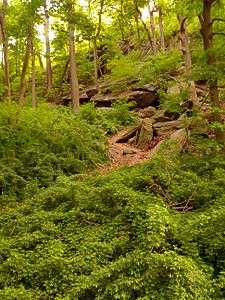 Lenape caves | |
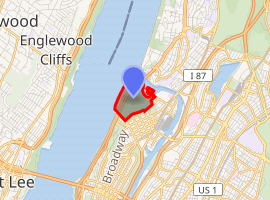
| |
| Type | Urban park |
| Location | Inwood, Manhattan, New York City |
| Area | 196.4 acres (79.5 ha) |
| Created | 1926 |
| Operated by | New York City Department of Parks and Recreation |
History
Site
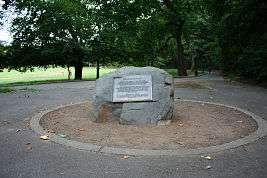
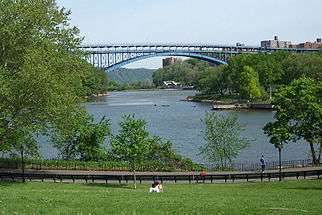
.jpg)
Inwood Hill Park has a human history that goes back to the Pre-Columbian era. Through the 17th century, Native Americans known as the Lenape inhabited the area. There is evidence of a main encampment along the eastern edge of the park. The Lenape relied on both the Hudson and Harlem Rivers as sources for food. Artifacts and the remains of old campfires were found in Inwood's rock shelters, suggesting their use for shelter and temporary living quarters. Legend has it that under a tulip tree in the park Peter Minuit, Director General of New Netherland, purchased Manhattan from the a band of Native Americans in 1626 for the Dutch West India Company; the purchase price being a shipment of goods worth 60 guilders. The tree, the largest tulip on the island, survived for centuries until it was felled by a storm in 1933. Until the 1950s the base of the tree under which this transaction allegedly took place was still to be seen, surrounded by a large iron fence, but as it rotted it was finally removed and a boulder (Shorakkopoch Rock) and plaque replaced it.
Fort Cockhill, one of many forts built in New York by the Continental Army during the Revolutionary War, stood slightly north from the center of Inwood Hill Park. A small, five-sided earthen structure equipped with two cannons, it overlooked the mouth of Spuyten Duyvil Creek at its confluence with the Hudson River. At the time, the area was known from Colonial to post–Revolutionary War times as Cox's Hill or Tubby Hook Hill.
Even though the area which is now Inwood Hill Park was the site of one of the last farms in Manhattan – which lasted to at least c. 1890[1] – by the 19th century it was largely the location of country retreats for some of the wealthier families of the community and the rest of New York's social elite.[2] One such notable who had a summer estate in Inwood was Isidor Straus, co-owner of the Macy's department store and a passenger on the ill-fated voyage of the RMS Titanic. The Lords of the Lord & Taylor department store chain owned two mansions built within the park; both mansions were destroyed by fire in the latter part of the 19th century. Additionally, an orphanage was located high on a bluff in what is now Inwood Hill Park in the nineteenth century. The site today includes a small paved area and park benches; no trace of the building remains. At least three freshwater springs arise in the park, one of which was used for drinking water by the workers who constructed the Henry Hudson Bridge.
Use as park
Andrew Haswell Green, who was in charge of the Central Park Commission, and responsible for laying out the streets on the Upper West Side and in Upper Manhattan, first suggested that a park be created in Inwood in 1895. His idea did not gain traction quickly, but the discovery of archeological finds in the area, the unique geology of the hill, historical associations (both true and merely rumored), the inherent beauty of the landscape and the views to be seen from it finally brought the city around,[3] and between 1915 and the early 1940s, it purchased parcels of land that make up the park as it is today.
The park was officially opened on May 8, 1926. Squatters who lived in the abandoned estates around the perimeter of the park were removed in the 1930s by Robert Moses and the Works Project Administration. The WPA also paved over some trails and illuminated them with lampposts, many of which are now in need of repair. Arson and dumping have damaged the park and its integrity, as have erosion-control measures which were not well conceived.[3]
On September 15, 1995, the Inwood Hill Nature Center was dedicated and opened to the public. It is located near the park entrance on 218th Street and Indian Road. The center is located on Manhattan's only salt-water marsh, and has been designated as an interactive exhibit with ongoing monitoring of the natural area. It is also the focal point to watch the eagles that have been placed in the park to be freed when they are able to adjust to the environment.[4]
Geography
The park covers 196.4 acres (79.5 ha).[5] The Henry Hudson Parkway and Amtrak's Empire Connection railroad line run through it, and at its northern end the Henry Hudson Bridge and the rail-only Spuyten Duyvil Bridge link Manhattan to the Bronx.
The park's western boundary is the Hudson River, and the southern boundary is Dyckman Street. From Dyckman Street to 204th Street the eastern boundary is Payson Avenue, from 204th to 214th Street it is Seaman Avenue, and from 215th Street to the park's end at 218th Street the eastern boundary is Indian Road.[5] 10 miles (16 km) footpaths criss-cross the park, allowing easy access to Dyckman Street, Fort Tryon Park, Fort Washington Park, and Riverside Park – part of the Manhattan Waterfront Greenway. Some of these trails are former roads leading to what were once summer estates that later were brought under the control of the city in the creation of the park.[6] Bolton Road, which was the main drive to the Bolton estate, is now the primary pedestrian pathway within the park; its entrance marked by a sign located on Payson Avenue.[5]
Inwood Hill Park is geologically diverse, with marble, schist, and limestone all prevalent in the area. The park is next to the seismologically active Dyckman Street Fault which runs parallel along the southern border of the park. As recently as 1989, activity of this fault caused a magnitude 2 earthquake.[7][8][9]
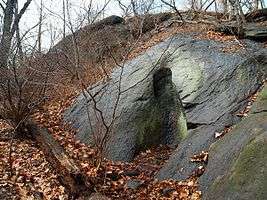
.jpg)
Fauna and flora
The area of the park along the Harlem River includes Muscota Marsh, one of Manhattan's last remaining natural salt marshes, the other being Smuggler's Cove, which attracts large numbers of waterbirds. These waterfowl can be studied further via educational programs held at the Nature Center at the north end of the property. Mallards, Canada geese and ring-billed gulls are year-round residents, using both the water and the nearby lawns and ballfields. Many wading birds and waterfowl pass through on the spring and fall migrations, and herons and cormorants often spend the summer. Also in the salt marsh can be found fish, mollusks and crustaceans among the cordgrass and bulrushes which can tolerate both salt and fresh water.[10]
The woods support a wide variety of birds, including common species such as blue jays and cardinals, as well as wild turkeys. Birds of prey that breed in the park include red-tailed hawks and owls. A five-year project that began in summer 2002 attempted to reintroduce the bald eagle to Manhattan using hacking boxes in the park and eaglets brought in from the Midwest. In the first summer, three of the four introduced eaglets fledged successfully; three or four fledged each year of the program.[11] The nesting structure was removed in 2009.[10]
The park also sustains many types of trees and flowers which are no longer extant elsewhere on Manhattan Island, such as Dicentra cucullaria, or "Dutchman's breeches". In 1918, Arthur Graves, then of the Yale School of Forestry and later a curator at the Brooklyn Botanic Garden, found in the park a species of chestnut tree which was resistant to a blight which was then attacking the bark of chestnut trees.[12]
Animals found in the park include Eastern and meadow voles, red-bellied salamanders, southern flying squirrels, opossums, white-footed deer mice, and cottontail rabbits, as well as the expected eastern grey squirrels and raccoons. Foxes were also once residents, but the increasing number of coyotes spotted in Central Park and in the Bronx's Van Cortlandt Park may account for the foxes' apparent current absence.[10]
Though the park does not support large wild mammals, the local wildlife does include raccoons and skunks as well as the usual city rodents. Both locals and people from outside the neighborhood fish from the riverbank at the north end of the park.
Usage
The park contains three children's playgrounds, baseball and soccer fields, and tennis and basketball courts.[6] The Inwood Hill Nature Center at the north end of the park is both a location for educational programs and the local headquarters of the Urban Park Rangers. Inwood Hill Park's ballfields are heavily used by local and other city Spanish-language leagues during the baseball season. This usage places extreme pressure on the park, which, as a result, has required more active management in recent years.
The lack of green space in the eastern part of Inwood and the Bronx nearby creates an enormous demand for picnicking with barbecues and table/chair setups, activity that is either illegal or tightly controlled in most city parks; however, Inwood Hill Park has managed this by permitting such setups on the manicured, maintained peninsula portion of the park.
References
Notes
- Eldredge & Horenstein, p. 9
- Unknown (December 26, 1886). "Big Woods Right In Town (Inwood in 1886)". New York World.
- Eldredge & Horenstein, pp. 36–37
- Renner, James (September 2003) "Inwood Hill Park" Washington Heights & Inwood Onine Archived September 2, 2010, at the Wayback Machine
- "Inwood Hill Park". New York City Department of Parks and Recreation. Retrieved July 26, 2009.
- Yarrow, Andrew L. (May 1, 1987). "Exploring Inwood Hill's Urban Wilderness". The New York Times. ISSN 0362-4331. Retrieved September 28, 2019.
- Fennell, Ryan (November 30, 1989). "Could It Happen Here? Earthquakes In The Tri-State Area". Two River Times. Archived from the original on July 19, 2011.
- Sykes, Lynn R.; et al. (August 2008). "Observations and Tectonic Setting of Historic and Instrumentally Located Earthquakes in the Greater New York City–Philadelphia Area" (PDF). Bulletin of the Seismological Society of America, Vol. 98, No. 4, pp. 1696–1719.
- Shahid, Alihay (March 17, 2011). "Could an earthquake hit New York City? History says yes, but not like 9.0 magnitude Japan earthquake". New York Daily News.
- Eldredge & Horenstein, pp.34-35
- City of New York/Parks and Recreation Eagles
- Eldredge & Horenstein, pp.32-26
Bibliography
- Eldredge, Niles & Horenstein, Sidney (2014). Concrete Jungle: New York City and Our Last Best Hope for a Sustainable Future. Berkeley, California: University of California Press. ISBN 978-0-520-27015-2.
